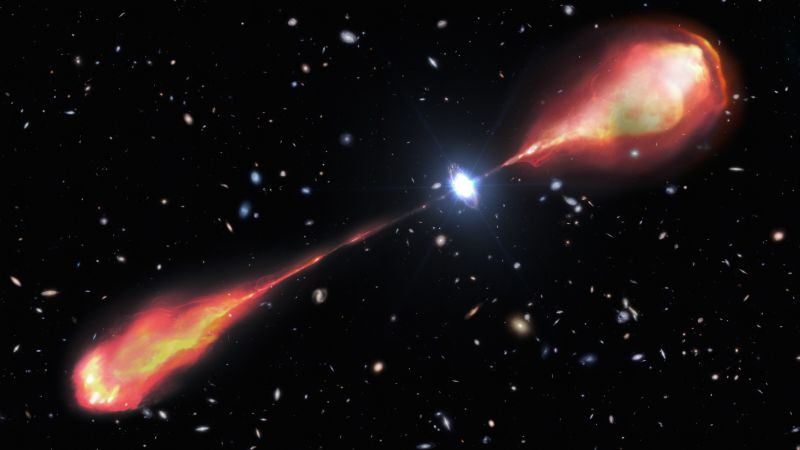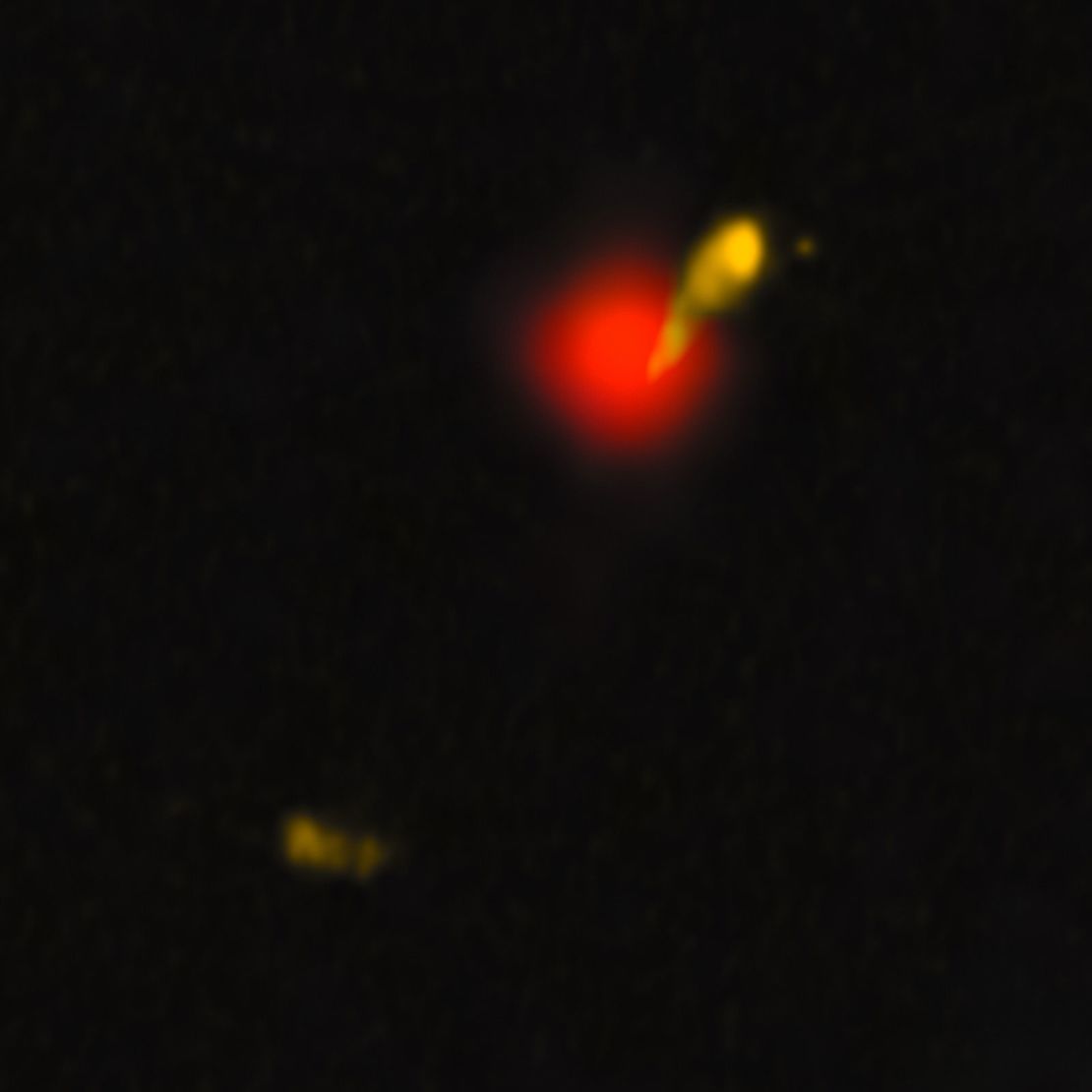
Subscribe to CNN’s Wonder Theory science newsletter. Delve into the cosmos with updates on remarkable discoveries and scientific progress.
CNN
—
In a remarkable discovery, astronomers have detected an enormous radio jet in the remote universe that is twice the diameter of the Milky Way galaxy. This ancient cosmic structure emerged when the universe was less than 10% of its current 13.8 billion-year age, as revealed by a recent study.
“This is the largest radio jet observed in the early Universe to date,” stated lead researcher Anniek Gloudemans, a postdoctoral fellow at the National Science Foundation’s NOIRLab, via email.
Previously, massive radio jets formed shortly after the Big Bang had largely evaded detection, and their origins remained puzzling, according to Gloudemans. “Their scarcity was often linked to the cosmic microwave background, which weakens the radio emissions from such distant objects,” she explained.
Predominantly, giant galaxies house a supermassive black hole at their core. These central monsters have immense gravitational influences, consuming whatever ventures too close. As they gather material, some black holes emit vast amounts of energy, believed to power the creation of a quasar—the brightest entities in the universe. Quasars, with their brilliant nuclei, eject jets of high-energy matter.
Utilizing two advanced radio telescopes, astronomers detected the massive two-lobed jet, which extends over at least 200,000 light-years. A light-year is the distance light travels in one year, equivalent to 5.88 trillion miles (9.46 trillion kilometers). This groundbreaking find was detailed in a study released on February 6 in The Astrophysical Journal Letters.
By utilizing telescopes to investigate the distant cosmos, astronomers can essentially witness events from the past. The identification of the colossal radio jet is like a glimpse into the universe’s formative years, offering insights into when the initial jets were formed and how they influenced galaxy development.
The quasar responsible for the two-lobed radio jet originated when the universe was under 1.2 billion years old, representing just 9% of its current age, and possesses some unique characteristics.
In astronomical terms, this quasar, with a mass 450 million times that of the Sun, is smaller than typical quasars, which can exhibit masses in the billions of solar equivalents.
“This suggests that an especially massive black hole isn’t a prerequisite to generate such powerful jets in the early universe,” Gloudemans noted in her statement.
The bipartite jet exhibits asymmetry in various aspects, including the distances it traverses from the quasar and its luminosity. “This seems to imply that a unique environment is influencing the lobes,” Gloudemans added.

An international group of astronomers first observed the radio jet using the Low Frequency Array (LOFAR) telescope, a collaborative network of radio telescopes across Europe. Subsequently, they conducted follow-up studies using various light wavelengths, including near-infrared observations through the Gemini Near-Infrared Spectrograph on the Gemini North telescope in Hawaii, along with visible light assessments via the Hobby-Eberly Telescope in Texas.
The combination of these different light spectra provided the team with vital insights into the massive jet and the quasar, identified as J1601+3102, which generated it.
“We aimed to locate quasars emitting strong radio jets in the early universe to comprehend their formation and influence on galaxy evolution,” Gloudemans remarked. “This object’s extreme nature enables us to observe it from Earth, despite its vast distance. It exemplifies what can be discovered through the integration of multiple telescopes operating across various wavelengths.”
The discovery of a substantial radio jet in the far universe indicates that there may be more such objects to uncover, Gloudemans stated, with plans for further observations aimed at unraveling the unique environment surrounding this quasar. Key questions remain about the conditions that lead to the formation of these powerful radio jets.
“Approximately a thousand quasars are currently known from this era and even earlier in the universe, suggesting they are rare yet identifiable,” Gloudemans elaborated. “Quasars achieve exceptional brightness through friction as gas and debris fall into the supermassive black hole. In this instance, some material has been expelled as two jets. We posit that these powerful radio jets emerge in about 10% of quasars. While jets have been seen even earlier in the universe, none have matched this unprecedented size.”
Cosmic Radio Jets: A Wider View
Another team of astronomers, also utilizing LOFAR, announced last autumn the detection of Porphyrion, an enormous pair of jets extending an astounding 23 million light-years—115 times more massive than the newly identified two-lobed radio jet.
However, unlike the jet formed by J1601+3102, Porphyrion is located 7.5 billion light-years away from Earth in what is considered the “nearby” universe, rather than the early cosmic epoch, according to a report published in September.
Detecting jets as colossal as Porphyrion would prove challenging in the early universe due to the lingering radiation from the Big Bang, which obscures the radio light emitted by such jets, explained Gloudemans.
Nevertheless, scientists have long pondered whether sweeping, powerful jets could be observed in the distant universe, as the black holes responsible for these jets exhibited different behaviors in the early cosmos and were less massive, said Martijn Oei, a postdoctoral researcher in observational astronomy at Caltech and lead author of the September study on Porphyrion. Oei was not involved in the recent study.
“What’s exciting is that these authors demonstrate that quasars—even when less massive than they are today—could still produce powerful, lengthy jets,” Oei stated via email. “The universe was significantly smaller during the era of Porphyrion, making the relative scale of observations lesser. This impressive finding shows that black holes influenced the universe with magnetism, heat, and cosmic rays extending beyond their galactic boundaries as early as a billion years after the Big Bang.”









